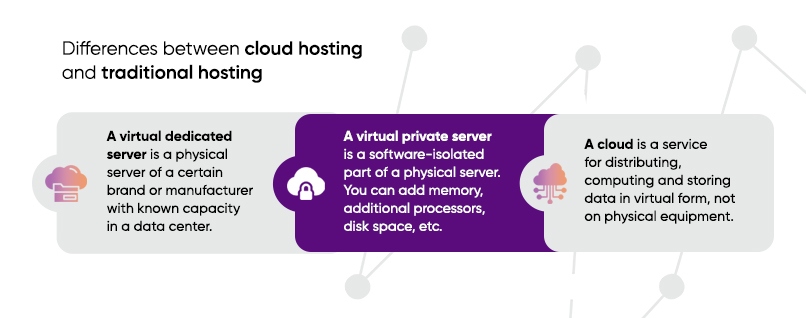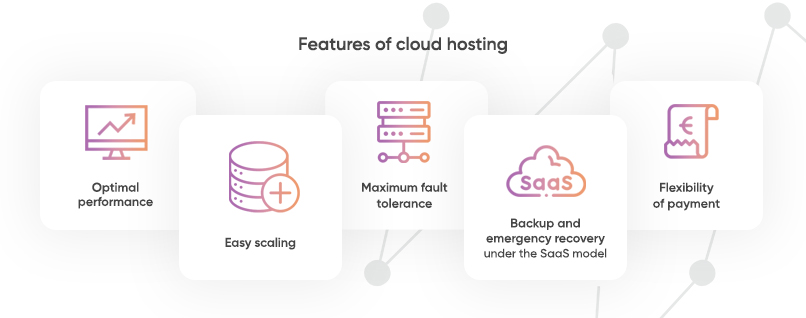Contents
Renting cloud hosting for a website is not as easy as it seems at first glance. It is not enough to go through a price list to choose a server in Europe. Hidden pitfalls and subtle nuances may turn into serious problems.
Find a link to our custom study on hosting providers in Europe below.
Hosting is a comprehensive solution for placing any information on the Internet. As a rule, a customer rents capacities from a provider and accesses server resources through the network.
Differences between cloud hosting and traditional hosting
There are three hosting types: a virtual dedicated server (VDS), a virtual private server (VPS) and a cloud (SaaS/PaaS/IaaS).
If we imagine that hosting is a house, then a virtual dedicated server will be a separate cottage owned by one owner but with limited space. A virtual private server is a rented apartment in an apartment building, and if there is little space in it, you need to quickly rent another apartment. Cloud service is comparable to a room in an office center where you can rent both a small room and an entire floor.

- A virtual dedicated server is a physical server of a certain brand or manufacturer with known capacity in a data center. Typically, a server is rented with basic configurations. If there is a potential need to scale, you have to calculate it in advance, since any reconfiguration requires a physical stop of your rented server. This can take hours and days: you will need to check the condition of the components, ensure that both the server and the engineer are available and agree on a work plan.
Some hosting providers offer more convenient custom projects. Their customers can choose a specific model or vendor, order a custom configuration.
- A virtual private server is a software-isolated part of a physical server. All resources that are part of the parent server are assigned to the VPS via the control panel. You can add more memory, additional processors, disk space, etc. Changing components and capacities for a virtual private server is quickly done either on the fly or by rebooting. This usually takes less than 15 minutes.
- A cloud is a service for distributing, computing and storing data in virtual form, not on physical equipment. Cloud hosting allows you to expand instantly. Cloud management goes through a provider, a pre-configured load balancer or a customer. For example, you can use an automatic expansion option if you need additional resources to scale on the fly.

The possibility of rapid expansion needs to be negotiated with the provider in advance. There are hybrid clouds where customers use part of the cloud for their calculations and some servers can instantly start running to distribute the load if needed. These clouds are in demand for e-commerce at certain peak moments (for example, during Christmas sales) when many buyers come to a website at the same time.
Volodymyr Marchenko
A VPS and a VDS are not that different, it is a dedicated server running in a virtual environment in both cases. But in the first case we have a virtual private server and in the second case we have a virtual dedicated server. The differences between a VPS and a cloud lie in their hardware infrastructure (centralised or distributed approach), flexibility, ways of scaling, manageability and availability.
Customers renting a VPS server pay a fixed fee, electricity and Internet connection costs. Customers with a VDS and a cloud are charged only for actual use of capacities and resources; in some cases, they have per-minute and per-second billing. That is why a virtual server and a cloud are always cheaper, but the performance of a VDS is lower than that of physical hardware. This is because a software layer takes over part of the resources.
Features of cloud hosting
- Optimal performance. A cloud has many servers combined into clusters to provide you with isolated computing power for your tasks. The computing cluster and the storage cluster are within the same network. The system provides content-related services quickly and smoothly regardless of the traffic flow.
- Easy scaling. The user can determine the parameters and number of virtual machines by adding or removing components and also set rules for transferring data between them.
- Maximum fault tolerance. There are different external storages for data recording and virtual machines run from different servers inside the cluster. This ensures seamless replacement of damaged components in case of failures and cyber attacks.
- Backup and emergency recovery run at the level of virtual machines or dedicated data provided under the SaaS model. In the first case, a separate server is created in the cloud, and in the second case, a service is provided: for example, access to a database with multi-level redundancy and its separate copies made in the cloud.
For example, a user can buy the right to host a database in a large cluster of servers and their database will be replicated and backed up between the servers. This means comprehensive database protection: it will be distributed over a number of servers both physically and geographically.
- Flexibility of payment. Cloud server hosting providers change their customers only for consumed resources, which means simplifies website budget planning. It is important to constantly monitor your consumption of resources to save money.

Cloud hosting options
A cloud server distributes resources on demand and maximises uptime. There are three main types of cloud hosting services:
- SaaS, Software as a Service.
- PaaS, Platform as a Service.
- IaaS, Infrastructure as a Service.
Other cloud hosting services are not that common:
- DCaaS, Data Center as a Service.
- MaaS, Mobility as a Service.
- NaaS, Network as a Service.
- SECaaS, SECurity as a Service.
- DaaS, Desktop as a Service.
- CaaS, Cloud as a Service.
- DBaaS, Database as a Service.
If we look at deployment models, there are public, private, hybrid cloud and multi-cloud solutions.
Cloud hosting involves the use of virtualisation technologies, network equipment, data storage and automation systems, cloud solutions, satellite and mobile access and multi-level protection.

When choosing a hosting provider, always look for multilingual customer support to quickly help you understand the technical part in your native language.
Olga Boujanova
Why choose cloud hosting
Clouds are optimal for companies with complex architecture, high- and medium-load projects, applications, as well as high requirements for scaling speed. These are:
- online stores;
- collaboration platforms;
- tools for storage and processing of data arrays;
- companies with assembly and test environments.
This type of hosting is suitable for managing domains, configuring FTP accounts, direct database editing.
The best cloud hosting. How to select a provider in Europe: selection’s criteria
These criteria need to be considered:
- type of supported applications;
- proposed functionality;
- cloud hosting fee;
- level of technical support;
- security level.
It is also better to choose your hosting provider from companies specialising in cloud services. They have a comprehensive approach to solving technical and organisational problems. It makes sense to pay attention to large system integrators who offer cloud hosting in addition to a large number of services.
How to select the best cloud hosting provider in Europe
Write us a message to get additional information.
or book a free consultation
How to find the best cloud solution
Only specialised cloud providers and data centers provide adequate technical support. It is necessary to look for a hosting provider who is ready not only to rent a cloud but also to support its customers.
Our team has analysed more than 20 cloud hosting providers in Europe and identified all their ins and outs. Based on the results of our analysis, we have listed the most important questions to help IT professionals and businesses choose a cloud in Europe. Find our guide linked below.

Article author
Volodymyr Marchenko
network engineer and a consultant in interactions with leading equipment vendors and manufactures
